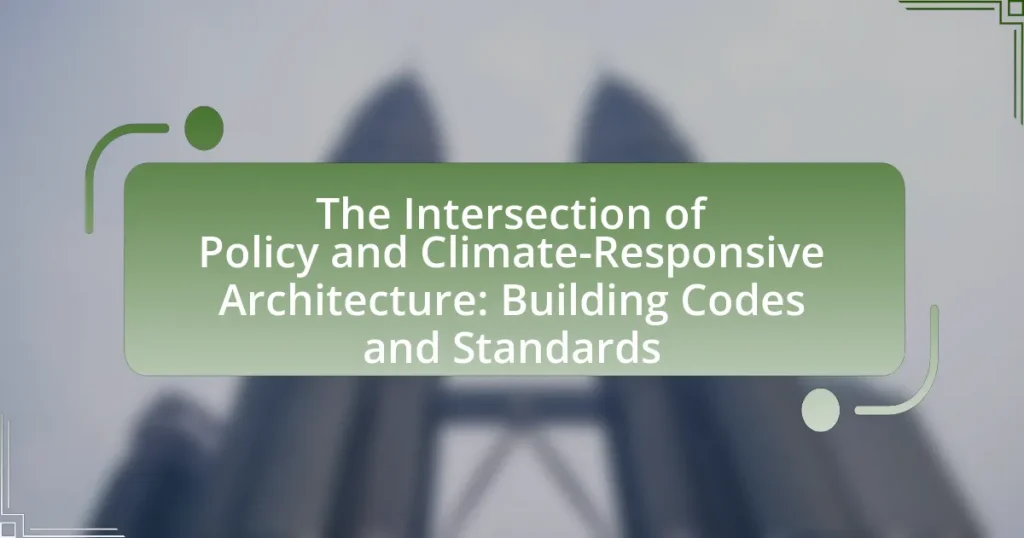The article examines the intersection of policy and climate-responsive architecture, focusing on how building codes and standards promote sustainable construction practices to mitigate climate change. It highlights the role of regulations, such as the International Energy Conservation Code, in influencing architectural design towards energy efficiency and reduced carbon emissions. Key components of building codes, including energy efficiency standards and sustainable materials requirements, are discussed, along with the challenges and barriers to implementing these codes. The article also explores the importance of collaboration between architects and policymakers, emerging trends in sustainable design, and the implications of certifications for marketability and value in climate-responsive architecture.

What is the Intersection of Policy and Climate-Responsive Architecture?
The intersection of policy and climate-responsive architecture involves the integration of regulatory frameworks that promote sustainable building practices to mitigate climate change impacts. Policies such as building codes and standards are designed to enforce energy efficiency, reduce carbon emissions, and encourage the use of renewable materials in construction. For instance, the International Energy Conservation Code (IECC) sets minimum energy efficiency requirements for residential and commercial buildings, directly influencing architectural design to prioritize sustainability. This alignment between policy and architecture is crucial for achieving national and international climate goals, as evidenced by the commitment of over 190 countries to the Paris Agreement, which emphasizes the need for sustainable urban development.
How do building codes influence climate-responsive architecture?
Building codes significantly influence climate-responsive architecture by establishing mandatory standards that promote energy efficiency, sustainable materials, and environmental performance. These codes often require the integration of renewable energy sources, improved insulation, and efficient HVAC systems, which directly contribute to reducing a building’s carbon footprint. For instance, the International Energy Conservation Code (IECC) sets benchmarks for energy use in buildings, encouraging designs that minimize energy consumption and enhance resilience to climate change. By enforcing these regulations, building codes ensure that new constructions adhere to practices that mitigate environmental impact, thereby fostering a more sustainable built environment.
What are the key components of building codes related to climate responsiveness?
The key components of building codes related to climate responsiveness include energy efficiency standards, sustainable materials requirements, water conservation measures, and climate adaptation strategies. Energy efficiency standards mandate the use of insulation, efficient HVAC systems, and renewable energy sources to reduce energy consumption and greenhouse gas emissions. Sustainable materials requirements promote the use of eco-friendly and locally sourced materials to minimize environmental impact. Water conservation measures, such as low-flow fixtures and rainwater harvesting systems, aim to reduce water usage and enhance resilience to drought. Climate adaptation strategies involve designing buildings to withstand extreme weather events, such as floods and heatwaves, ensuring safety and longevity. These components collectively contribute to creating buildings that are not only functional but also environmentally responsible and resilient to climate change.
How do these components promote sustainable design practices?
Building codes and standards promote sustainable design practices by establishing regulations that require energy efficiency, resource conservation, and environmental protection in construction. These components ensure that new buildings meet specific criteria for insulation, energy use, and material sourcing, which reduces overall carbon footprints. For example, the International Energy Conservation Code mandates minimum energy performance standards, leading to a significant reduction in energy consumption and greenhouse gas emissions in buildings. By enforcing these standards, policymakers drive the adoption of sustainable technologies and practices, ultimately fostering a more environmentally responsible built environment.
Why is the integration of policy important in architecture?
The integration of policy is crucial in architecture because it ensures that building designs comply with regulations that promote safety, sustainability, and community welfare. Policies such as building codes and zoning laws establish standards that architects must follow to mitigate risks, enhance energy efficiency, and address environmental concerns. For instance, the International Building Code sets minimum safety requirements that protect occupants and property, while energy codes aim to reduce carbon footprints and promote climate-responsive design. These policies guide architects in creating structures that not only meet aesthetic and functional needs but also align with broader societal goals, such as public health and environmental sustainability.
What role does government policy play in shaping architectural standards?
Government policy plays a crucial role in shaping architectural standards by establishing regulations that ensure safety, sustainability, and accessibility in building design. These policies often include building codes that dictate structural integrity, energy efficiency, and environmental impact, thereby influencing how architects and builders approach their projects. For instance, the International Building Code (IBC) sets minimum safety standards for construction in the United States, which architects must adhere to in their designs. Additionally, government incentives for green building practices, such as tax credits for energy-efficient designs, further guide architectural standards towards climate-responsive solutions.
How can policy changes drive innovation in climate-responsive design?
Policy changes can drive innovation in climate-responsive design by establishing new building codes and standards that prioritize sustainability and energy efficiency. For instance, the adoption of stricter energy efficiency regulations can incentivize architects and builders to develop innovative materials and technologies that reduce carbon footprints. A notable example is California’s Title 24, which mandates energy-efficient building practices and has led to advancements in solar energy integration and passive design strategies. These regulatory frameworks not only encourage the adoption of cutting-edge solutions but also create a competitive market for sustainable design, ultimately fostering a culture of innovation in the architecture and construction industries.
What challenges exist at the intersection of policy and architecture?
Challenges at the intersection of policy and architecture include regulatory compliance, funding limitations, and the integration of sustainability goals. Regulatory compliance often leads to conflicts between innovative architectural designs and existing building codes, which may not accommodate new materials or technologies. Funding limitations can restrict the implementation of climate-responsive designs, as policies may not allocate sufficient resources for sustainable initiatives. Additionally, integrating sustainability goals into architectural practices can be hindered by a lack of interdisciplinary collaboration among policymakers, architects, and engineers, resulting in fragmented approaches to climate-responsive architecture.
What are the common barriers to implementing climate-responsive building codes?
Common barriers to implementing climate-responsive building codes include lack of political will, insufficient funding, and limited technical expertise. Political will is often hindered by competing interests and short-term economic considerations, which can delay or obstruct the adoption of necessary regulations. Insufficient funding restricts the ability of local governments and agencies to develop and enforce these codes, as well as to provide incentives for compliance. Additionally, limited technical expertise among builders, architects, and regulators can lead to misunderstandings or misapplications of climate-responsive principles, further complicating implementation efforts. These barriers collectively impede progress toward more sustainable building practices.
How do economic factors influence the adoption of these policies?
Economic factors significantly influence the adoption of climate-responsive building policies by determining the financial feasibility and incentives for compliance. For instance, higher construction costs associated with implementing sustainable materials and technologies can deter developers unless offset by government subsidies or tax incentives. According to a study by the International Energy Agency, investments in energy-efficient buildings can yield a return of up to 30% over time, illustrating that economic benefits can drive policy adoption when financial incentives align with long-term savings. Additionally, market demand for sustainable buildings often correlates with economic conditions; during economic downturns, the prioritization of cost-cutting measures may lead to reduced adoption of stringent building codes.
How can stakeholders collaborate to enhance building codes?
Stakeholders can collaborate to enhance building codes by forming multidisciplinary committees that include architects, engineers, policymakers, and community representatives. These committees can conduct joint assessments of existing codes, identify gaps, and propose updates that reflect current environmental standards and technological advancements. For instance, the International Code Council regularly engages stakeholders through public forums and technical committees to revise the International Building Code, ensuring that diverse perspectives are considered in the code development process. This collaborative approach not only fosters innovation but also ensures that building codes are responsive to the needs of the community and the environment.
What are the emerging trends in climate-responsive architecture?
Emerging trends in climate-responsive architecture include the integration of biophilic design, the use of sustainable materials, and the implementation of smart building technologies. Biophilic design emphasizes the connection between nature and built environments, promoting well-being and reducing energy consumption through natural ventilation and daylighting. Sustainable materials, such as recycled and locally sourced products, are increasingly prioritized to minimize environmental impact. Smart building technologies, including energy management systems and IoT devices, enhance energy efficiency and adaptability to climate conditions. These trends are supported by evolving building codes and standards that encourage sustainable practices and resilience against climate change.
How are new technologies influencing building standards?
New technologies are significantly influencing building standards by enabling enhanced energy efficiency, sustainability, and safety measures. Innovations such as smart building systems, advanced materials, and energy modeling software allow for more precise compliance with updated codes that prioritize environmental impact and occupant health. For instance, the integration of Building Information Modeling (BIM) facilitates better planning and resource management, leading to reduced waste and improved energy performance. Additionally, the adoption of renewable energy technologies, such as solar panels and energy storage systems, is increasingly reflected in building codes that encourage or mandate their use, aligning with global sustainability goals. These advancements are reshaping regulatory frameworks to ensure that new constructions meet modern environmental and safety standards.
What innovative practices are being adopted in the industry?
Innovative practices being adopted in the architecture industry include the integration of sustainable building materials, energy-efficient design, and smart technology systems. These practices aim to reduce carbon footprints and enhance energy performance in line with evolving building codes and standards. For instance, the use of cross-laminated timber has gained traction due to its lower environmental impact compared to traditional materials like concrete and steel. Additionally, energy modeling software is increasingly utilized to optimize building performance before construction, ensuring compliance with stringent energy codes. According to the U.S. Green Building Council, buildings that adhere to LEED certification standards demonstrate a significant reduction in energy use, showcasing the effectiveness of these innovative practices in achieving climate-responsive architecture.

What are the specific building codes and standards for climate-responsive architecture?
Specific building codes and standards for climate-responsive architecture include the International Green Construction Code (IgCC), ASHRAE 90.1 for energy efficiency, and LEED certification requirements. The IgCC establishes minimum requirements for energy efficiency, water conservation, and indoor environmental quality, promoting sustainable building practices. ASHRAE 90.1 sets performance standards for energy use in buildings, ensuring that designs minimize energy consumption. LEED certification, developed by the U.S. Green Building Council, provides a framework for assessing building sustainability across various categories, including energy, water, and materials. These codes and standards collectively guide architects and builders in creating structures that respond effectively to climate challenges while promoting sustainability.
What are the most recognized building codes globally?
The most recognized building codes globally include the International Building Code (IBC), the National Building Code of Canada (NBCC), and the Eurocodes. The IBC, developed by the International Code Council, is widely adopted in the United States and serves as a model for many state and local codes. The NBCC is the primary building code in Canada, providing guidelines for construction and safety standards. Eurocodes are a set of European standards that cover structural design and are used across EU member states, ensuring consistency in building practices. These codes are essential for promoting safety, sustainability, and resilience in construction worldwide.
How do these codes vary by region or country?
Building codes vary significantly by region or country due to differences in climate, cultural practices, economic conditions, and regulatory frameworks. For instance, countries in colder climates, such as Canada and Norway, implement stricter insulation and heating requirements in their building codes to enhance energy efficiency and occupant comfort. In contrast, tropical regions like Southeast Asia focus on ventilation and moisture control to combat humidity and heat, leading to different structural and material specifications. Additionally, the International Building Code (IBC) serves as a model in many jurisdictions, but local adaptations reflect specific environmental challenges and safety concerns, such as earthquake-resistant designs in Japan and fire safety regulations in Australia. These variations ensure that building practices align with local needs and conditions, promoting safety and sustainability.
What are the implications of these variations for architects?
Variations in building codes and standards have significant implications for architects, as they directly influence design practices, material selection, and compliance requirements. Architects must adapt their designs to meet diverse regulations that can vary by region, impacting energy efficiency, sustainability, and safety measures. For instance, stricter energy codes may require architects to incorporate advanced insulation materials and renewable energy systems, thereby increasing initial costs but potentially leading to long-term savings and environmental benefits. Additionally, architects must stay informed about evolving standards to ensure their projects are compliant, which can affect timelines and project feasibility. This necessity for adaptability underscores the importance of continuous education and collaboration with policymakers to align architectural practices with climate-responsive goals.
How do standards for energy efficiency impact building design?
Standards for energy efficiency significantly influence building design by mandating specific performance criteria that architects and builders must meet. These standards, such as the International Energy Conservation Code (IECC) and ASHRAE 90.1, require the integration of energy-efficient materials, systems, and technologies, which leads to designs that prioritize insulation, energy-efficient windows, and renewable energy sources. For instance, buildings designed under these standards often feature advanced HVAC systems and smart technologies that optimize energy use, resulting in reduced operational costs and lower carbon footprints. Compliance with these standards not only enhances the sustainability of buildings but also aligns with global efforts to mitigate climate change, as evidenced by the increasing adoption of green building certifications like LEED, which further incentivize energy-efficient design practices.
What are the key metrics used to measure energy efficiency in buildings?
The key metrics used to measure energy efficiency in buildings include Energy Use Intensity (EUI), which quantifies energy consumption per square foot annually, and the Building Performance Index (BPI), which assesses overall energy performance relative to similar buildings. Additionally, metrics such as the Energy Star rating, which indicates a building’s energy performance compared to peers, and the HERS Index, which measures a home’s energy efficiency on a scale, are also critical. These metrics are validated by various studies and standards, including the U.S. Department of Energy’s guidelines, which emphasize the importance of quantifiable energy performance for compliance with building codes and standards.
How can architects ensure compliance with these standards?
Architects can ensure compliance with building codes and standards by integrating regulatory requirements into their design processes from the outset. This involves thorough research of local, state, and national codes, as well as engaging with relevant authorities during the planning stages. For instance, the International Building Code (IBC) provides a framework that architects must follow to meet safety, accessibility, and sustainability standards. Additionally, architects can utilize compliance checklists and software tools designed to assess adherence to these regulations throughout the design and construction phases. Regular training and updates on code changes also help architects maintain compliance effectively.
What role do certifications play in climate-responsive architecture?
Certifications play a crucial role in climate-responsive architecture by establishing standards that guide sustainable design and construction practices. These certifications, such as LEED (Leadership in Energy and Environmental Design) and BREEAM (Building Research Establishment Environmental Assessment Method), provide frameworks for assessing the environmental performance of buildings, ensuring they meet specific energy efficiency, resource conservation, and indoor environmental quality criteria. For instance, LEED-certified buildings are designed to reduce energy consumption by 30% to 50% compared to conventional structures, demonstrating the effectiveness of certification in promoting sustainable architecture.
What are the most important certifications for sustainable buildings?
The most important certifications for sustainable buildings are LEED (Leadership in Energy and Environmental Design), BREEAM (Building Research Establishment Environmental Assessment Method), and ENERGY STAR. LEED, developed by the U.S. Green Building Council, is widely recognized and focuses on various sustainability aspects, including energy efficiency, water usage, and indoor environmental quality. BREEAM, originating in the UK, assesses the sustainability performance of buildings and encourages the use of sustainable materials and practices. ENERGY STAR, a program by the U.S. Environmental Protection Agency, specifically targets energy efficiency in buildings, providing a benchmark for energy performance. These certifications are critical as they guide the construction and operation of buildings towards environmentally responsible practices, contributing to reduced carbon footprints and enhanced occupant health.
How do these certifications affect marketability and value?
Certifications significantly enhance marketability and value in the realm of climate-responsive architecture. These certifications, such as LEED (Leadership in Energy and Environmental Design) or BREEAM (Building Research Establishment Environmental Assessment Method), signal to potential buyers and investors that a building meets high standards of sustainability and energy efficiency. For instance, a study by the U.S. Green Building Council found that LEED-certified buildings can command rental premiums of up to 20% compared to non-certified buildings. This premium reflects the growing demand for environmentally responsible properties, which are increasingly favored in the market. Additionally, properties with recognized certifications often experience lower operating costs due to energy efficiency, further enhancing their overall value.

How can architects and policymakers work together for better outcomes?
Architects and policymakers can collaborate effectively by integrating climate-responsive design principles into building codes and standards. This partnership ensures that architectural practices align with regulatory frameworks, promoting sustainable development. For instance, the International Energy Agency reports that implementing energy-efficient building codes can reduce energy consumption in buildings by up to 30%. By working together, architects can provide insights on innovative design solutions, while policymakers can facilitate the adoption of these solutions through supportive legislation and incentives. This synergy leads to improved environmental outcomes and enhances community resilience against climate change.
What strategies can be employed for effective collaboration?
Effective collaboration can be achieved through clear communication, defined roles, and shared goals. Clear communication ensures that all team members understand their tasks and the project’s objectives, which is crucial in the context of climate-responsive architecture where policies and standards may vary. Defined roles help to streamline responsibilities, allowing each member to focus on their expertise, such as compliance with building codes or sustainable design practices. Shared goals foster a unified vision, essential for aligning efforts towards climate-responsive outcomes. Research indicates that teams with well-defined communication strategies and collaborative frameworks are 25% more effective in achieving project milestones, particularly in complex fields like architecture and policy integration.
How can feedback loops between architects and policymakers improve building codes?
Feedback loops between architects and policymakers can improve building codes by facilitating the exchange of practical insights and regulatory needs, leading to more effective and adaptable standards. Architects provide firsthand knowledge of design challenges and innovations, while policymakers offer the regulatory framework and public safety considerations. This collaboration can result in building codes that not only enhance safety and sustainability but also reflect the latest advancements in architectural practices. For instance, the integration of energy efficiency measures in building codes has been driven by feedback from architects who understand the implications of design choices on energy consumption. Such iterative communication ensures that building codes evolve in response to real-world applications and emerging technologies, ultimately fostering a built environment that is both resilient and responsive to climate challenges.
What role does public engagement play in shaping building standards?
Public engagement plays a critical role in shaping building standards by ensuring that community needs and preferences are incorporated into the regulatory framework. Engaging the public allows for diverse perspectives, which can lead to more effective and sustainable building codes that reflect local values and environmental considerations. For instance, studies have shown that when communities participate in the development of building standards, there is often a greater emphasis on energy efficiency and resilience to climate change, as seen in the adoption of the International Green Construction Code, which was influenced by stakeholder input. This collaborative approach not only enhances compliance but also fosters a sense of ownership among residents, ultimately leading to better implementation of building standards.
What best practices should be followed in climate-responsive architecture?
Best practices in climate-responsive architecture include optimizing building orientation, utilizing passive solar design, incorporating natural ventilation, and selecting sustainable materials. Optimizing building orientation enhances energy efficiency by maximizing natural light and minimizing heat loss. Passive solar design techniques, such as thermal mass and shading, help regulate indoor temperatures, reducing reliance on mechanical heating and cooling systems. Natural ventilation strategies improve air quality and comfort while decreasing energy consumption. Additionally, selecting sustainable materials, such as recycled or locally sourced products, minimizes environmental impact and supports resource conservation. These practices are supported by various studies, including the “International Energy Agency’s Energy Efficiency 2020 Report,” which highlights the importance of energy-efficient design in reducing greenhouse gas emissions.
How can architects incorporate local climate data into their designs?
Architects can incorporate local climate data into their designs by analyzing specific weather patterns, temperature ranges, humidity levels, and seasonal variations to inform building orientation, materials selection, and energy efficiency strategies. For instance, utilizing data from the National Oceanic and Atmospheric Administration (NOAA) allows architects to optimize natural ventilation and daylighting, reducing reliance on artificial heating and cooling systems. This approach not only enhances occupant comfort but also aligns with sustainable design principles, as evidenced by studies showing that climate-responsive designs can lower energy consumption by up to 30%.
What are the key considerations for sustainable material selection?
Key considerations for sustainable material selection include environmental impact, resource availability, and lifecycle assessment. Environmental impact focuses on minimizing harm to ecosystems and reducing carbon footprints, while resource availability ensures that materials are sourced sustainably and are renewable or recyclable. Lifecycle assessment evaluates the environmental effects of a material from extraction through production, use, and disposal, providing a comprehensive view of its sustainability. These considerations are essential for aligning with building codes and standards that promote climate-responsive architecture.
What are the future directions for building codes and climate-responsive architecture?
Future directions for building codes and climate-responsive architecture include the integration of sustainability metrics, enhanced energy efficiency standards, and the incorporation of climate resilience strategies. These developments aim to address the urgent need for buildings to minimize their environmental impact while adapting to changing climate conditions. For instance, the International Energy Agency reports that implementing stricter energy codes could reduce global energy demand by 20% by 2040. Additionally, the adoption of performance-based codes encourages innovative design solutions that prioritize renewable energy sources and sustainable materials, aligning with global climate goals.
How might climate change influence future building regulations?
Climate change will likely lead to stricter building regulations aimed at enhancing resilience and sustainability. As extreme weather events become more frequent and severe, regulations will evolve to require buildings to withstand higher temperatures, increased flooding, and stronger storms. For instance, the International Code Council has already begun integrating climate resilience into building codes, emphasizing energy efficiency and sustainable materials. Additionally, studies indicate that regions experiencing rising sea levels are implementing new zoning laws to restrict development in vulnerable areas, demonstrating a direct response to climate change impacts.
What innovations are on the horizon for sustainable architecture?
Innovations on the horizon for sustainable architecture include advanced materials, energy-efficient technologies, and smart building systems. These innovations aim to reduce carbon footprints and enhance resource efficiency. For instance, the development of biophilic design principles integrates natural elements into buildings, promoting occupant well-being while minimizing environmental impact. Additionally, the use of carbon-negative materials, such as hempcrete and mycelium, is gaining traction, as they sequester carbon during their lifecycle. Furthermore, smart technologies, including IoT sensors and AI-driven energy management systems, optimize energy use and improve building performance. According to the World Green Building Council, buildings that incorporate these innovations can achieve up to 80% reduction in energy consumption compared to traditional structures.




